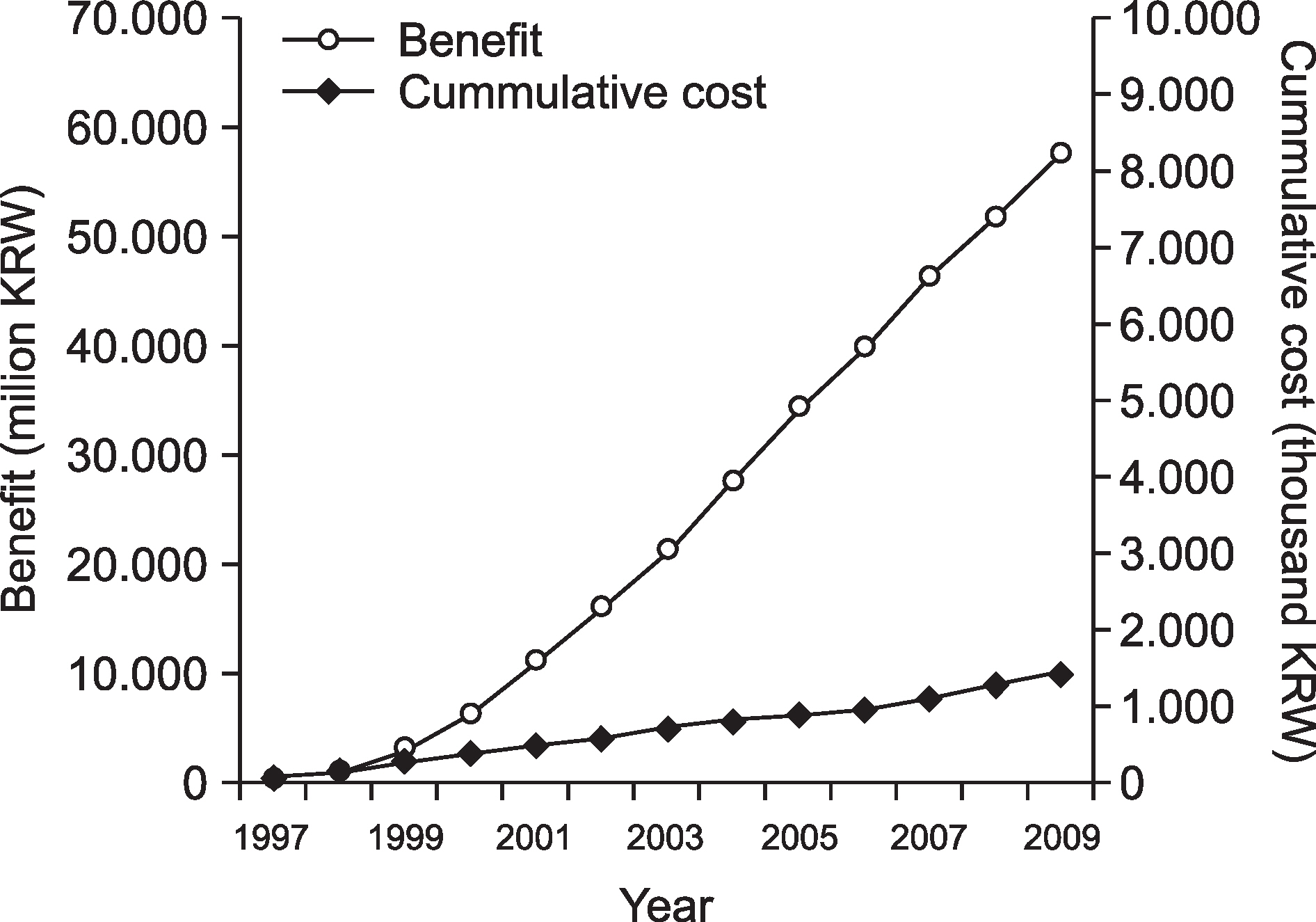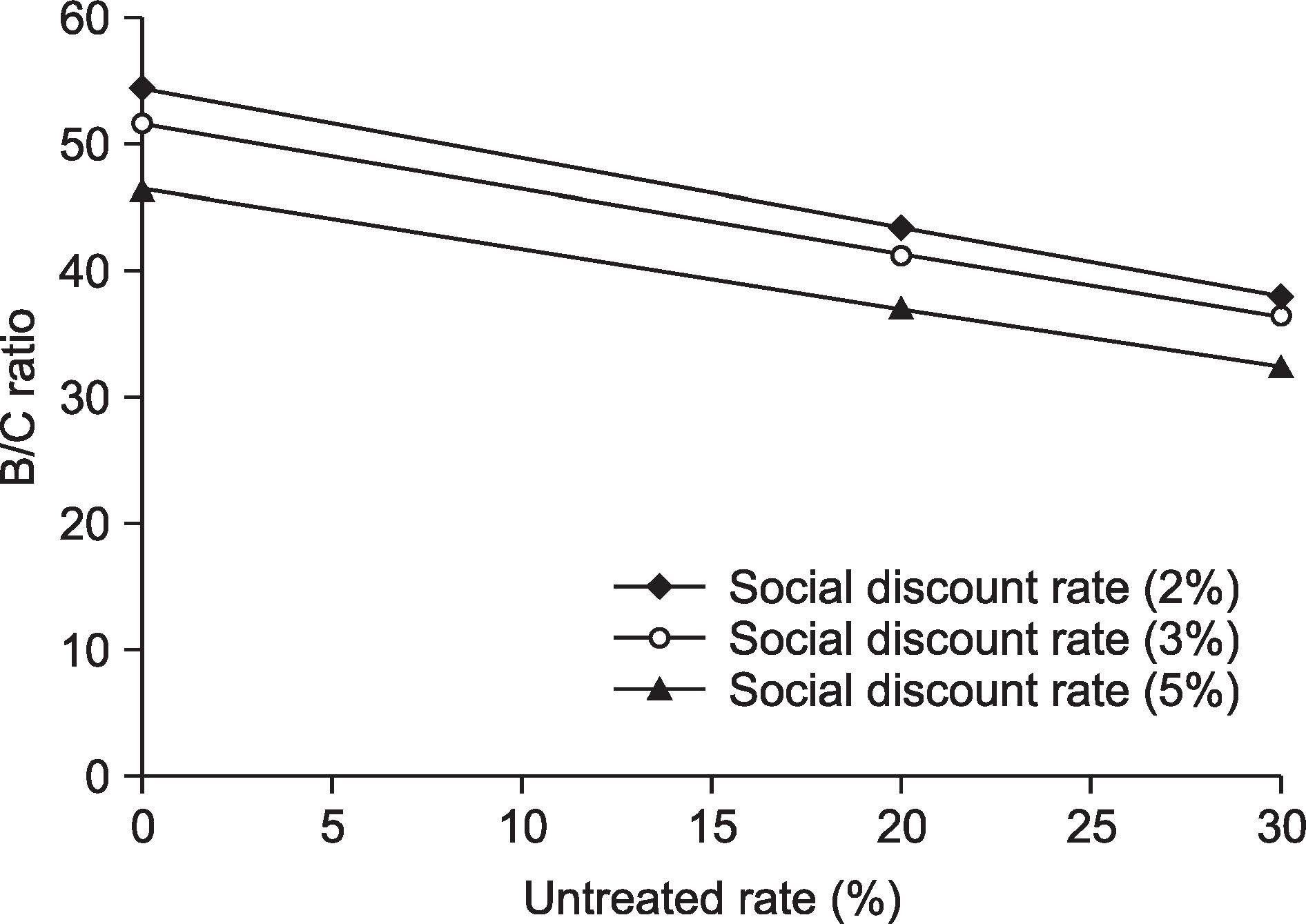J Korean Acad Oral Health.
2014 Jun;38(2):118-128.
Cost-benefit analysis of a water fluoridation program for 11 years in Jinju, Korea
- Affiliations
-
- 1Department of Preventive and Community Dentistry, Pusan National University School of Dentistry, Yangsan, Korea. jbomkim@pusan.ac.kr
- 2Department of Preventive and Social Dentistry, Seoul National University School of Dentistry, Seoul, Korea.
Abstract
OBJECTIVES
The aim of this study was to estimate the economic costs and benefits of a water fluoridation program in the city of Jinju, Korea.
METHODS
In 2009, dental surveys were conducted on 2,315 children aged 6-12 years in Jinju, which had been fluoridated for 11 years. The decayed/missing/filled teeth (DMFT) scores of children in Jinju were compared to the DMFT scores of same-aged children in non-fluoridated small- and medium-sized cities in the fourth Korean National Health and Nutrition Examination Survey conducted from 2007 to 2009 by the Korea Centers for Disease Control and Prevention. The reduced number of decayed permanent teeth by the water fluoridation program was estimated as the difference between the DMFT scores of children in Jinju and those in non-fluoridated small- and medium-sized cities. The economic benefits were estimated by the savings from reduced dental treatment costs by using the reduced number of decayed permanent teeth from the water fluoridation program. All annual costs and benefits were calculated from 1998 to 2009. The social rate and untreated rate of decayed teeth were applied as 3% and 20%, respectively. The annual benefit-cost ratio was estimated by using the annual benefits and cumulative program costs.
RESULTS
The economic benefit in 2009 from a water fluoridation program was estimated as 57,496,000,000 Korean Won (KRW), and the cumulative cost in 2009 was estimated as 1,387,000,000 KRW. The net present value in 2009 from a water fluoridation program was 56,109,000,000 KRW. The benefit-cost ratio in 2009 was estimated as 41.4.
CONCLUSIONS
The economic benefit of a water fluoridation program in Jinju city was evaluated as excellent.
Keyword
MeSH Terms
Figure
Reference
-
References
1. Kim JB, Kim SG, Lee YS, Son KJ, Jeon JG, Chang KW. Characteristics and anatomical surface of sealant with tooth type in children at Chonju city, Korea. J Korean Acad Oral Health. 2005; 29:33–42.2. Garcia-Godoy F, Harris NO, Helm DM. Pit and fissure sealants. Harris NO, Garcia-Godoy F, editors. Primary preventive dentistry. 6th ed.Upper Saddle River: Appleton & Lange;2004. p. 285–318.3. Moon HS, Jung JY, Horowitz AM, Ma DS, Paik DI. Korean dental hygienists’ knowledge and opinions about etiology and prevention of dental caries. Community Dent Oral Epidemiol. 1998; 26:296–302.
Article4. World Health Organization. Prevention methods and programmes for oral diseases. Methods for preventing dental caries. Geneva: World Health Organization, Technical report series. 1984; 713:12–20.5. Crawford PR. Fifty years of fluoridation. J Can Dent Assoc. 1995; 61:585–588.6. Kargul B, Caglar E, Tanboga I. History of water fluoridation. J Clin Pediatr Dent. 2003; 27:213–218.
Article7. National Center for Chronic Disease Prevention and Health Promotion. Fluoridation status [Internet]. [cited 2012 Mar 7]. Available from:. http://apps.nccd.cdc.gov/nohss/FluoridationV.asp.8. Ast DB, Fitzgerald B. Effectiveness of water fluoridation. J Am Dent Assoc. 1962; 65:581–588.
Article9. Davis GN. Cost and benefit in fluoride in the prevention of dental caries. Geneva: World Health Organization;1974. p. 2–17.10. Ludwig TG. Hastings fluoridation project; IV. Dental effects between 1954 and 1970. New Zealand Dent J. 1971; 67:155–160.11. Spencer AJ. Contribution of fluoride vehicles to change in caries severity in Austalian adolescents. Community Dent Oral Epidemiol. 1986; 14:238–241.12. Ministry of Health and Welfare. Workshop for water fluoridation program in 2000. Seoul: Ministry of Health & Welfare;2000. p. 6–12.13. Ministry of Health and Welfare. 2011 Guideline for water fluoridation program. Seoul: Ministry of Health & Welfare;2009. p. 73.14. Kim JB, Paik DI, Moon HS, Song YH, Park DY, Jung SH. Effect of water fluoridation on dental caries prevention in 11-year-old Korean children. J Korean Acad Oral Health. 1997; 23:583–592.15. Kim DY, Kim BJ, Lee SM, Bae KH, Kang NE, Kim JB. Evaluation of caries preventive effect from a 6-year community water fluoridation program in Jinju, Korea. J Korean Acad Oral Health. 2006; 30:347–359.16. Chin IJ, Kim DH, Lee SM, Lee SW, Bae KH, Kim JB. Caries preventive effect on primary teeth by community water fluoridation program in metropolitan city-comparison of Ulsan and Busan Metropolitan City, Korea. J Korean Acad Oral Health. 2007; 31:224–234.17. White BA, Antczak-Bouckoms AA, Weinstein MC. Issues in the economic evaluation of community water fluoridation. J Dent Educ. 1989; 53:646–657.
Article18. Drummond M, Stoddart G, Labelle R, Cushman R. Health economics: an introduction for clinicians. Ann Intern Med. 1987; 107:88–92.
Article19. Statistics Korea. Korea Statistical Information System (KOSIS), Statistics DB, Regional Statistics, Statistics of Water Supply in Jinju [Internet]. [cited 2012 Mar 2]. Available from:. http://kosis.kr/region/region_03List.jsp.20. World Health Organization. Oral Health Survey. Basic Methods. 4th ed.Geneva: World Health Organization;1997. p. 39–46.21. Kim JB, Kim JB. A study on the evaluation of water fluoridation in the Republic of Korea. Seoul Nat’l Univ J Dental College. 1988; 12(2):1–29.22. Chung HU, Ahn HS, Park HK, Moon HS, Cho SH, Lee HY, et al. Cost benefit analysis on the economic effect of the water fluoridation program in some area of Cheong-Ju City. Korean J Health Policy & Administration. 2003; 13:23–45.23. Ministry of Health and Welfare. 2010 Korean National Oral Health Survey: III. Survey Report. Seoul: Ministry of Health & Welfare;2011. p. 265–266.24. Lewis DW, Banting DW. Water fluoridation: current effectiveness and dental fluorosis. Community Dent Oral Epidemiol. 1994; 22:153–158.
Article25. Gillcrist JA, Brumley DE, Blackford JU. Community fluoridation status and caries experience in children. J Public Health Dent. 2001; 61:168–171.
Article26. Han DH, Kim JB, Park DY. The decline in dental caries among children of different ages in Korea, 2000-2006. Int Dent J. 2010; 60:329–335.27. Dini EL, Holt RD, Bedi R. Comparison of two indices of caries patterns in 3-6 year old Brazilian children from areas with different fluoridation histories. Int Dent J. 1998; 48:378–385.
Article28. Moon HS, Cho SH, Ahn HS, Kim JB, Sung JH. A study on the outcome evaluation of water fluoridation program. School of Dentistry, Seoul Nat’l Univ & Affiliated Research Institute. 2000; 65–74.29. Cavanagh JG. Water fluoridation; Part II. Estimate of cost-effectiveness on the fluoridation project in Peninsular Malaysia. Assignment report ICP/ORH/001. Regional Office for The Western Pacific Bureau of World Health Organization;1984. p. 19–27.30. Lee HS, Chang KW, Kim JB, Kim DK, Kim KS, Park DY, et al. The effectiveness of community water fluoridation in Korea. Health Promotion Research Program, Policy. 11–15. [Internet]. (cited 2012 May 16]. Available from:. http://research.hp.go.kr/hpRe-search. Seoul:Korea Health Promotion Foundation. 2011; 134-135.
- Full Text Links
- Actions
-
Cited
- CITED
-
- Close
- Share
- Similar articles
-
- Caries reduction effect of permanent teeth from community water fluoridation program for 17 years in Jinju city
- Related factors of the approval for the community water fluoridation program in Incheon Metropolitan City
- Preventive effect of a 18-year water fluoridation program for dental caries in a rural area of Korea
- Awareness Survey on Community Water Fluoridation by Region
- Economic evaluation of v accinations - a methodologic review



